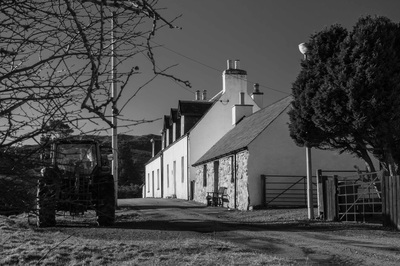|
I set out to produce a collection of images that would record the crofting cultural landscape of the Balmacara Estate, focusing upon some of the main natural and cultural features both large and small in scale. I wanted to interpret the landscape in an attractive artistic manner as well as simply to record it in a documentary style. I also wanted to illustrate the relationship between the people who live and work in this landscape and continue to define it through their management of it as crofters. As part of my research for the project I found a great many images, in different formats and styles including photographs and paintings, that seek to represent the crofting landscape. Often these images present a romantic notion of crofting that does not necessarily reflect the true hardship and challenges associated with working this remote and challenging land. I also investigated my two main photographic inspirations in more detail. I chose Ansel Adams because of his truly inspiring black & white images of landscapes in other parts of the world. His use of dramatic lighting and high contrast and the application of his zone system and pre-visualisation was something I wanted to try and understand better and emulate if possible. Paul Strand on the other hand was chosen partly because of his incredible portraits and to a lesser extent the political nature of his photography, but in no small part because of the piece of work he did in 1954 when he visited Uist to photograph that crofting area and its inhabitants. His book Tir A’Mhurain is an outstanding collection of images from a time gone by to some extent and yet in many ways still resonates with the crofting landscape of Balmacara today. His detailed images of doors and windows and traditional buildings and townships reflected the sort of features in the landscape that I wanted to try and capture. The portraits, while only a small part of my project have incredible subtle tones and are so timeless in many ways. While he used a very formal posed approach to his compositions I wanted to try and take a more candid approach, which worked reasonably well but did lead to may rejections due to movement blur of what might otherwise have been good images compositionally. Some Examples of my Inspirational Photographers The project was carried out during the winter and early spring and this limited my options in terms of subject matter to some extent. Ideally I would have liked to have been able to capture images of the crops growing and the annual harvest, the species-rich meadows, the birds and insects associated with the croft land and the general patterns of change in the landscape throughout the seasons but obviously this was not possible within the available timeframe. In many senses the scope for focusing upon the more natural elements of the landscape was limited more by this seasonal restriction than the cultural aspect. As a result the final collection of images perhaps has a more cultural bias than I would have really wanted. The reduced levels of colour in the landscape due to the low light of winter meant that on many occasions there was limited contrast and interest in the images I captured. That, along with my main inspirations, led to me choose the black & white format for my images as this emphasised the tonal range and textures. Also, with these low levels of light I did use a tripod quite a lot to enable slower shutter speeds, thus maintaining a small aperture for maximum depth of field. In some cases this did not work as well as I had hoped due to windy conditions but it is something that I did not do a lot of before the project and I intend to use more in the future. This also helps slow up the process forcing me to engage a bit more thought in my composition, exposure settings and the like. Also, with the generally low angle of light at this time of year I frequently found myself shooting into bright back light. I also wanted to maximise the tonal range in my shots and as this is fairly restricted with digital cameras, I regularly used HDR merging to improve this. Hence, in most cases I adopted the use of the AEB function on my camera, apart from for moving subjects, but did not always apply the HDR technique. When converting to black & white I really found this brought out the details and contrast really well, frequently rendering the images much more dramatic and interesting to view. I tried to avoid using too many of the more artistic pre-sets available in some HDR software as I feel they lead to an unnatural effect which can be quite distracting from the main subject. In relation to my specific images I wanted to achieve clear sharp images with high contrast and engaging compositions. I think I achieved this quite well in most cases. I did have a few other images that I liked but they were perhaps not quite sharp enough, e.g. the image of the Highland Bull. My portraits were reasonably successful but I preferred the subtle tones of those shot on film as opposed to digital. I was very pleased that the film shots came out reasonably well exposed but I did not take enough advantage of the film, partly due to time and cost. I consider the two triptychs worked well and using this format allowed me to provide a better representation of the range of windows and doors in the townships. In some ways it would be nice to put together a small series of collection of different subjects such as old barns, doors, windows, tractors and equipment, etc. and this might be a good project for the future. My Final Twelve Images
0 Comments
Leave a Reply. |
AuthorI am an amateur photographer who is also a Chartered Geographer with his own part-time consultancy business and I work as an estate manager for a national conservation charity in Scotland. I am based in Lochalsh, Wester Ross, Scotland, just next to the Isle of Skye. SalesIf you like my photos and are interested in purchasing prints, whether framed, mounted or otherwise please click here.
Archives
May 2024
Categories |




















 RSS Feed
RSS Feed